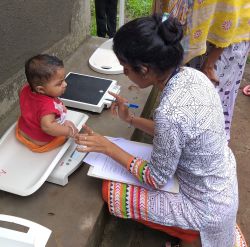Prevalence and predictors of undernutrition among children under two years in Narmada District, Gujarat State, Western India: a community-based cross-sectional study
Abstract
Background: Globally, addressing undernutrition has been recognised as a development priority. In India, undernutrition continues to be the topmost risk factor for morbidity and associated mortality. The Government of India, though the National Nutrition Strategy, aims to reduce child mortality by preventing and reducing undernutrition among children. The aim of this study was to estimate prevalence and predictors of undernutrition among children under two years in Narmada district of Gujarat state, India.
Methods: A community-based cross-sectional survey was completed between July and August 2019. A probability sample of 400 children under two years of age were surveyed. A structured tool was used to collect data on exposures- socioeconomic conditions, dietary diversity, maternal care, infant feeding practices, household food insecurity, and child morbidity. The WHO child growth standards (2006) were used to measure the outcome (wasting, stunting and underweight). We used multivariate logistic regression analysis to identify the predictors of undernutrition.
Results: The prevalence of wasting, stunting, and underweight were 32.2% (95% CI: 27.0-37.9), 34.5% (95% CI: 29.5-39.8), and 39.7% (95% CI: 33.9-45.8), respectively. Household income >10000 Indian Rupees-INR (OR: 0.61, 95% CI: 0.4, 0.90), maternal stature ≥145 cm (OR: 0.43, 95% CI: 0.21, 0.86) and child age 0-6 months (OR: 1.61, 95% CI: 1.00-2.56) were significantly associated with wasting. Household income (OR: 0.50, 95% CI: 0.26, 0.97), livestock ownership (OR 2.36: 95% CI: 1.25, 4.44), maternal body mass index ≥ 18.5 (OR: 0.63, 95% CI: 0.42, 0.95), and child age 7-23 months (OR: 5.89, 95% CI: 3.03, 11.45) were significantly associated with stunting. Maternal stature ≥145 cm (OR: 0.46, 95% CI: 0.23, 0.95) was significantly associated with underweight.
Conclusions: In Narmada, the prevalence of undernutrition among children under two years is high. To improve the situation, targeting the nutritional status of adolescent girls and mothers, strengthening already existing programs, and education on hygiene should be considered.

Authors retain all copyrights. In making a submission to World Nutrition, they are certifying that all material is theirs except quotations, as indicated, and that they have obtained permission for any photos, tables, or graphics taken from other publications or websites.




